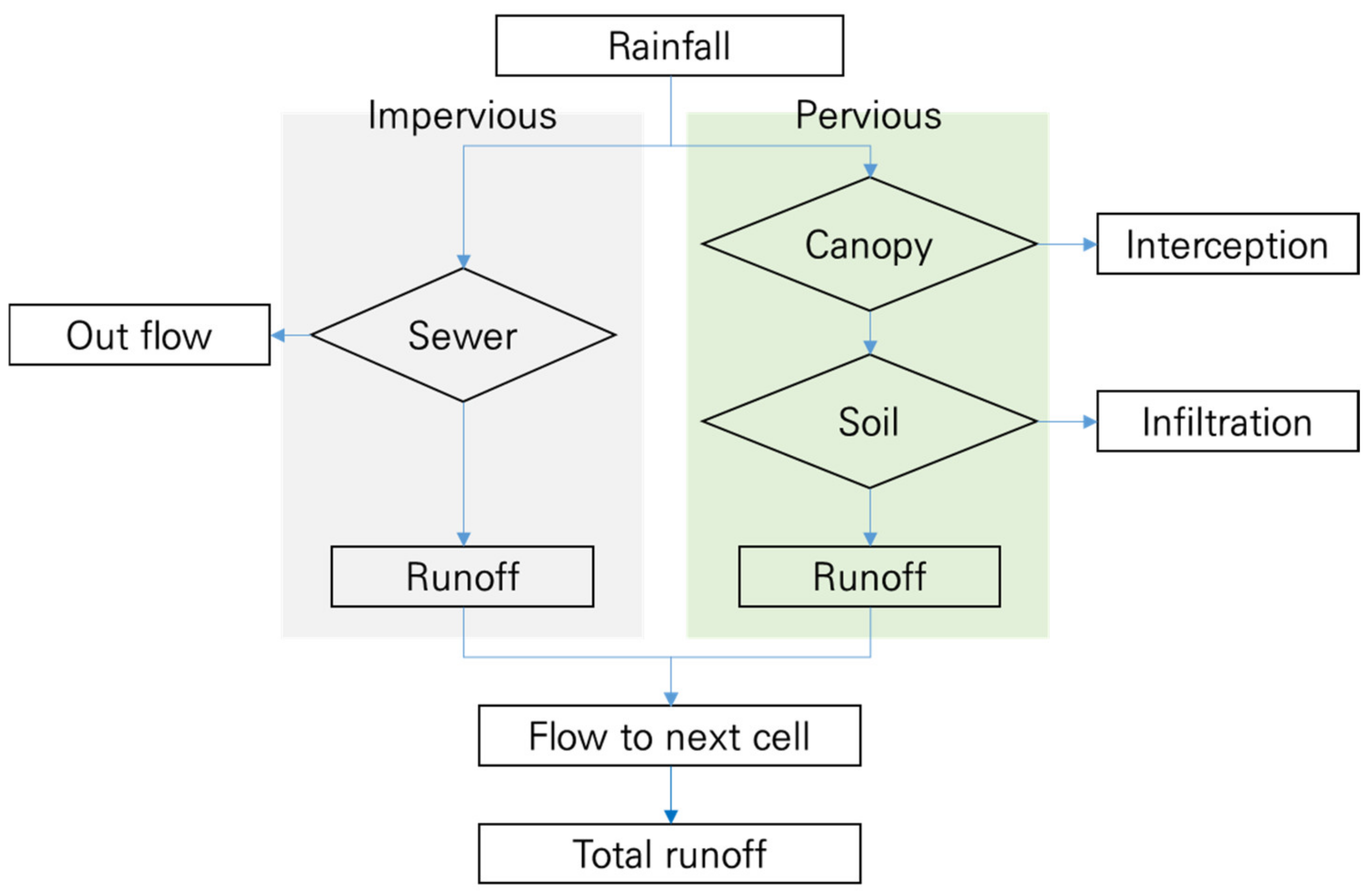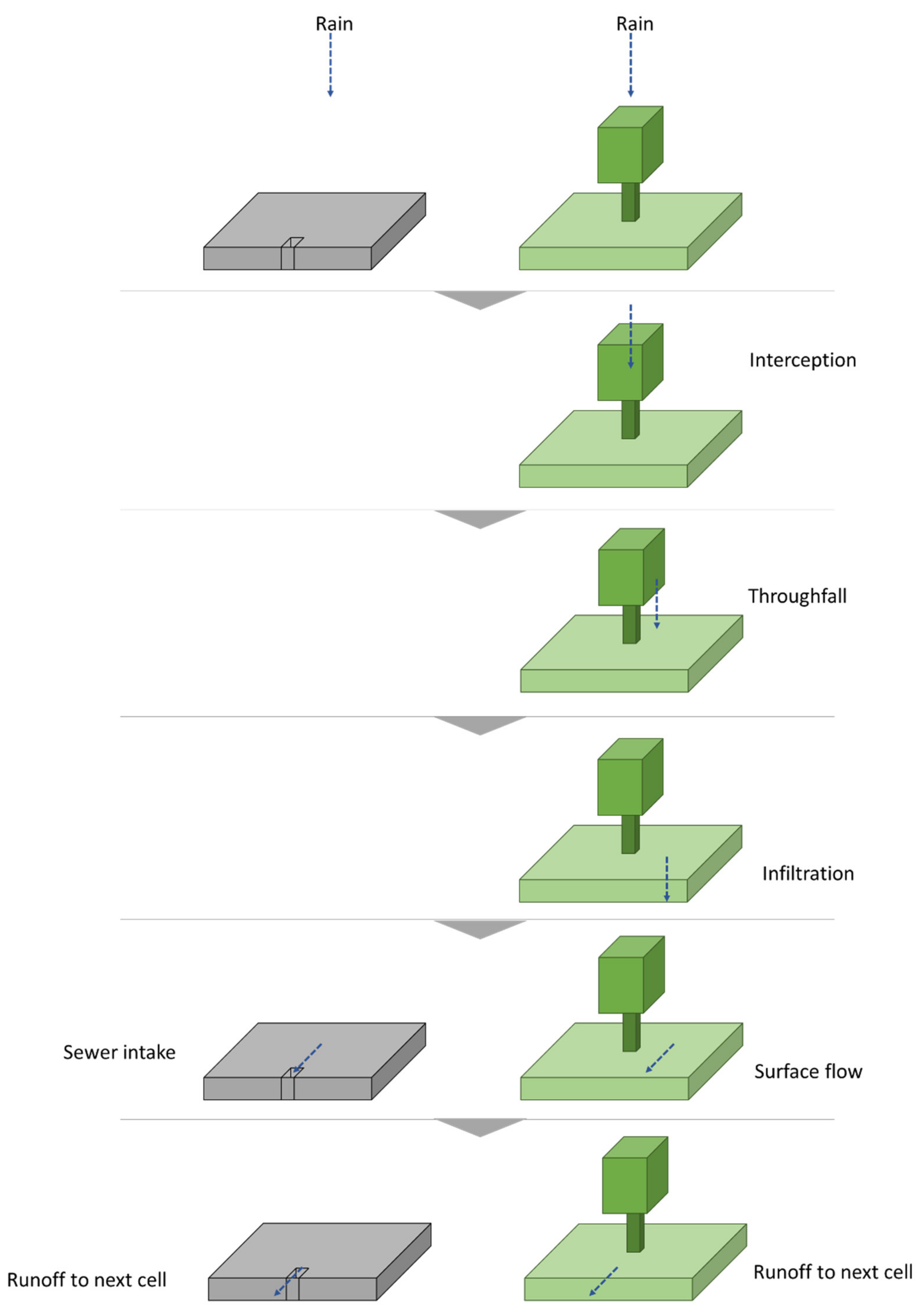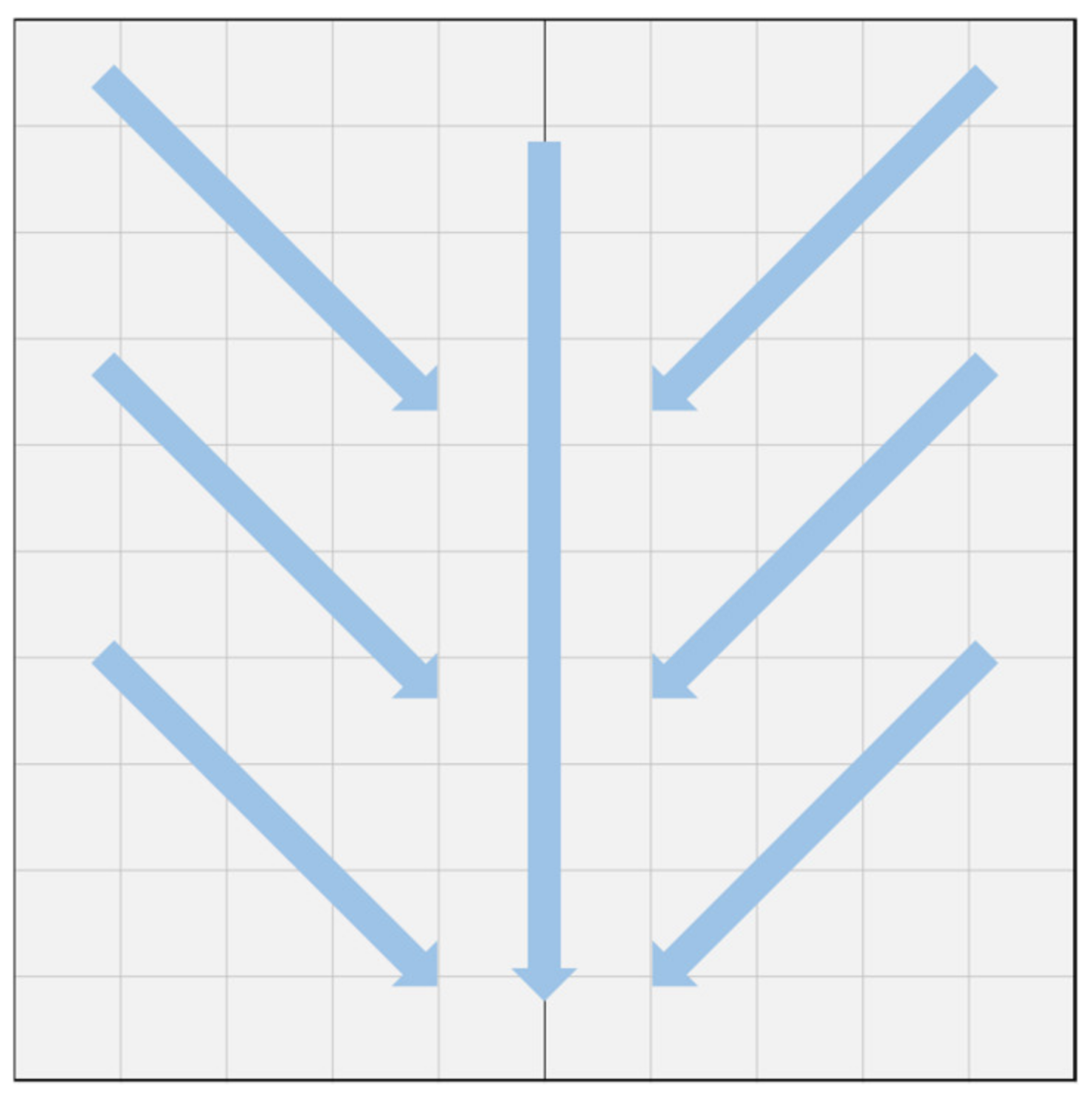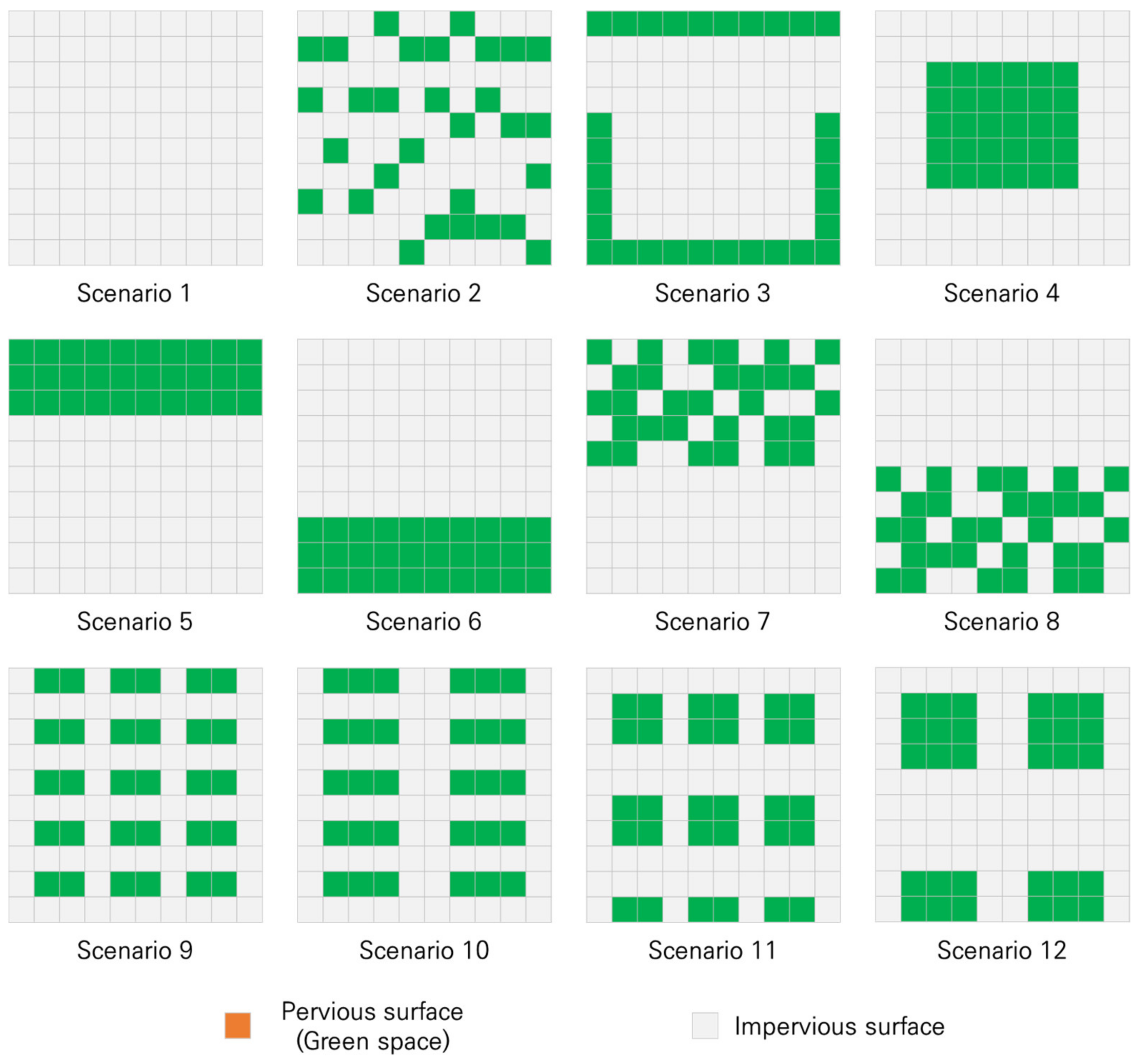Urban Green Space Arrangement for an Optimal Landscape Planning Strategy for Runoff Reduction
Abstract
:1. Introduction
2. Literature Review
3. Materials and Methods
3.1. Model Description
3.2. Virtual Domain Setting
3.3. Scenario Setting
4. Results
5. Discussion
6. Conclusions
Author Contributions
Funding
Conflicts of Interest
References
- Fiedler, P.; Zannin, P. Noise Mapping as a Tool for the Development. J. Sci. Ind. Res. 2015, 74, 114–116. [Google Scholar]
- Panichelli, L.; Gnansounou, E. Estimating greenhouse gas emissions from indirect land-use change in biofuels production: Concepts and exploratory analysis for soybean-based biodiesel production. J. Sci. Ind. Res. 2008, 67, 1017–1030. [Google Scholar]
- Hammond, M.J.; Chen, A.S.; Djordjević, S.; Butler, D.; Mark, O. Urban flood impact assessment: A state-of-the-art review. Urban Water J. 2015, 12, 14–29. [Google Scholar] [CrossRef] [Green Version]
- Kim, H.; Lee, D.K.; Sung, S. Effect of urban green spaces and flooded area type on flooding probability. Sustainability 2016, 8, 134. [Google Scholar] [CrossRef] [Green Version]
- Brody, S.; Kim, H.; Gunn, J. Examining the Impacts of Development Patterns on Flooding on the Gulf of Mexico Coast. Urban Stud. 2013, 50, 789–806. [Google Scholar] [CrossRef]
- Hood, M.J.; Clausen, J.C.; Warner, G.S. Comparison of stormwater lag times for low impact and traditional residential development. J. Am. Water Resour. Assoc. 2007, 43, 1036–1046. [Google Scholar] [CrossRef]
- Bonebrake, T.C.; Mastrandrea, M.D. Tolerance adaptation and precipitation changes complicate latitudinal patterns of climate change impacts. Proc. Natl. Acad. Sci. USA 2010, 107, 12581–12586. [Google Scholar] [CrossRef] [Green Version]
- Carter, J.G.; Handley, J.; Butlin, T.; Gill, S. Adapting cities to climate change—Exploring the flood risk management role of green infrastructure landscapes. J. Environ. Plan. Manag. 2018, 61, 1535–1552. [Google Scholar] [CrossRef] [Green Version]
- Intergovernmental Panel on Climate Change. Workshop Report of the Intergovernmental Panel on Climate Change Workshop on Socio-Economic Scenarios; IPCC Working Group III Technical Support Unit, Potsdam Institute for Climate Impact Research: Potsdam, Germany, 2010; pp. 1–51. [Google Scholar]
- Oki, T.; Kanae, S. Global Hydrological Cycles and Word Water Resources. Science 2006, 313, 1068–1072. [Google Scholar] [CrossRef] [Green Version]
- Miller, J.D.; Kim, H.; Kjeldsen, T.R.; Packman, J.; Grebby, S.; Dearden, R. Assessing the impact of urbanization on storm runoff in a peri-urban catchment using historical change in impervious cover. J. Hydrol. 2014, 515, 59–70. [Google Scholar] [CrossRef] [Green Version]
- Foley, J.A.; Defries, R.; Asner, G.P.; Barford, C.; Bonan, G.; Carpenter, S.R.; Chapin, F.S.; Coe, M.T.; Daily, G.C.; Gibbs, H.K.; et al. Review Global Consequences of Land Use. Science 2005, 8, 570–574. [Google Scholar] [CrossRef] [Green Version]
- La Rosa, D.; Privitera, R. Characterization of non-urbanized areas for land-use planning of agricultural and green infrastructure in urban contexts. Landsc. Urban Plan. 2013, 109, 94–106. [Google Scholar] [CrossRef]
- Dong, X.; Guo, H.; Zeng, S. Enhancing future resilience in urban drainage system: Green versus grey infrastructure. Water Res. 2017, 124, 280–289. [Google Scholar] [CrossRef] [PubMed]
- Torresan, S.; Critto, A.; Rizzi, J.; Marcomini, A. Assessment of coastal vulnerability to climate change hazards at the regional scale: The case study of the North Adriatic Sea. Nat. Hazards Earth Syst. Sci. 2012, 12, 2347–2368. [Google Scholar] [CrossRef]
- Ahern, J. Urban landscape sustainability and resilience: The promise and challenges of integrating ecology with urban planning and design. Landsc. Ecol. 2013, 28, 1203–1212. [Google Scholar] [CrossRef]
- Elmqvist, T.; Andersson, E.; Frantzeskaki, N.; McPhearson, T.; Olsson, P.; Gaffney, O.; Takeuchi, K.; Folke, C. Sustainability and resilience for transformation in the urban century. Nat. Sustain. 2019, 2, 267–273. [Google Scholar] [CrossRef]
- Elderbrock, E.; Enright, C.; Lynch, K.A.; Rempel, A.R. A guide to public green space planning for urban ecosystem services. Land 2020, 9, 391. [Google Scholar] [CrossRef]
- Arnold, J.; Kleemann, J.; Fürst, C. A differentiated spatial assessment of urban ecosystem services based on land use data in Halle, Germany. Land 2018, 7, 101. [Google Scholar] [CrossRef]
- Jaffe, M. Environmental Reviews & Case Studies: Reflections on Green Infrastructure Economics. Environ. Pract. 2010, 12, 357–365. [Google Scholar] [CrossRef]
- Montalto, F.; Behr, C.; Alfredo, K.; Wolf, M.; Arye, M.; Walsh, M. Rapid assessment of the cost-effectiveness of low impact development for CSO control. Landsc. Urban Plan. 2007, 82, 117–131. [Google Scholar] [CrossRef]
- Dunne, T.; Leopold, L.B. Water in Environmental Planning; Macmillan: New York City, NY, USA, 1978. [Google Scholar]
- Cortinovis, C.; Zulian, G.; Geneletti, D. Assessing nature-based recreation to support urban green infrastructure planning in Trento (Italy). Land 2018, 7, 112. [Google Scholar] [CrossRef] [Green Version]
- Guo, R.; Bai, Y. Simulation of an urban-rural spatial structure on the basis of green infrastructure assessment: The case of Harbin, China. Land 2019, 8, 196. [Google Scholar] [CrossRef] [Green Version]
- Zellner, M.; Massey, D.; Minor, E.; Gonzalez-Meler, M. Exploring the effects of green infrastructure placement on neighborhood-level flooding via spatially explicit simulations. Comput. Environ. Urban Syst. 2016, 59, 116–128. [Google Scholar] [CrossRef] [Green Version]
- Lennon, M.; Scott, M.; O’Neill, E. Urban Design and Adapting to Flood Risk: The Role of Green Infrastructure. J. Urban Des. 2014, 19, 745–758. [Google Scholar] [CrossRef]
- Kozak, D.; Henderson, H.; de Castro Mazarro, A.; Rotbart, D.; Aradas, R. Blue-green infrastructure (BGI) in dense urban watersheds. The case of the Medrano stream basin (MSB) in Buenos Aires. Sustainability 2020, 12, 163. [Google Scholar] [CrossRef] [Green Version]
- Shi, L. Beyond flood risk reduction: How can green infrastructure advance both social justice and regional impact? Socio-Ecological Pract. Res. 2020, 2, 311–320. [Google Scholar] [CrossRef]
- Lee, H.; Song, K.; Kim, G.W.; Chon, J. Flood-adaptive green infrastructure planning for urban resilience. Landsc. Ecol. Eng. 2021, in press. [Google Scholar] [CrossRef]
- Benton-Short, L.; Keeley, M.; Rowland, J. Green infrastructure, green space, and sustainable urbanism: Geography’s important role. Urban Geogr. 2019, 40, 330–351. [Google Scholar] [CrossRef]
- Hong, Y.M. Experimental evaluation of design methods for in-site detention ponds. Int. J. Sediment Res. 2010, 25, 52–63. [Google Scholar] [CrossRef]
- Berggren, K.; Packman, J.; Ashley, R.; Viklander, M. Climate changed rainfalls for urban drainage capacity assessment. Urban Water J. 2014, 11, 543–556. [Google Scholar] [CrossRef]
- Liu, W.; Chen, W.; Peng, C. Influences of setting sizes and combination of green infrastructures on community’s stormwater runoff reduction. Ecol. Model. 2015, 318, 236–244. [Google Scholar] [CrossRef]
- Baek, S.S.; Choi, D.H.; Jung, J.W.; Lee, H.J.; Lee, H.; Yoon, K.S.; Cho, K.H. Optimizing low impact development (LID) for stormwater runoff treatment in urban area, Korea: Experimental and modeling approach. Water Res. 2015, 86, 122–131. [Google Scholar] [CrossRef]
- Jia, Z.; Tang, S.; Luo, W.; Li, S.; Zhou, M. Small scale green infrastructure design to meet different urban hydrological criteria. J. Environ. Manag. 2016, 171, 92–100. [Google Scholar] [CrossRef]
- Berland, A.; Shiflett, S.A.; Shuster, W.D.; Garmestani, A.S.; Goddard, H.C.; Herrmann, D.L.; Hopton, M.E. The role of trees in urban stormwater management. Landsc. Urban Plan. 2017, 162, 167–177. [Google Scholar] [CrossRef] [PubMed] [Green Version]
- Ghimire, C.P.; Bruijnzeel, L.A.; Lubczynski, M.W.; Bonell, M. Rainfall interception by natural and planted forests in the Middle Mountains of Central Nepal. J. Hydrol. 2012, 475, 270–280. [Google Scholar] [CrossRef]
- Alves, P.L.; Formiga, K.T.M.; Traldi, M.A.B. Rainfall interception capacity of tree species used in urban afforestation. Urban Ecosyst. 2018, 21, 697–706. [Google Scholar] [CrossRef]
- Pereira, F.L.; Gash, J.H.C.; David, J.S.; Valente, F. Evaporation of intercepted rainfall from isolated evergreen oak trees: Do the crowns behave as wet bulbs? Agric. For. Meteorol. 2009, 149, 667–679. [Google Scholar] [CrossRef] [Green Version]
- Ekwue, E.I.; Harrilal, A. Effect of soil type, peat, slope, compaction effort and their interactions on infiltration, runoff and raindrop erosion of some Trinidadian soils. Biosyst. Eng. 2010, 105, 112–118. [Google Scholar] [CrossRef]
- Gregory, J.; Dukes, M.; Jones, P.; Miller, G. Effect of urban soil compaction on infiltration rate. J. Soil Water Conserv. 2006, 61, 117–124. [Google Scholar]
- Armson, D.; Stringer, P.; Ennos, A.R. The effect of street trees and amenity grass on urban surface water runoff in Manchester, UK. Urban For. Urban Green. 2013, 12, 282–286. [Google Scholar] [CrossRef]
- Hoang, L.; Fenner, R.A. System interactions of stormwater management using sustainable urban drainage systems and green infrastructure. Urban Water J. 2016, 13, 739–758. [Google Scholar] [CrossRef] [Green Version]
- Burns, M.J.; Fletcher, T.D.; Walsh, C.J.; Ladson, A.R.; Hatt, B.E. Hydrologic shortcomings of conventional urban stormwater management and opportunities for reform. Landsc. Urban Plan. 2012, 105, 230–240. [Google Scholar] [CrossRef]
- Jato-Espino, D.; Charlesworth, S.M.; Bayon, J.R.; Warwick, F. Rainfall-runoff simulations to assess the potential of suds for mitigating flooding in highly urbanized catchments. Int. J. Environ. Res. Public Health 2016, 13, 149. [Google Scholar] [CrossRef]
- Ahiablame, L.; Shakya, R. Modeling flood reduction effects of low impact development at a watershed scale. J. Environ. Manag. 2016, 171, 81–91. [Google Scholar] [CrossRef]
- Damodaram, C.; Giacomoni, M.H.; Prakash Khedun, C.; Holmes, H.; Ryan, A.; Saour, W.; Zechman, E.M. Simulation of combined best management practices and low impact development for sustainable stormwater management. J. Am. Water Resour. Assoc. 2010, 46, 907–918. [Google Scholar] [CrossRef]
- Barah, M.; Khojandi, A.; Li, X.; Hathaway, J.; Omitaomu, O.F. Optimizing green infrastructure placement under precipitation uncertainty. Omega 2021, 100, 102196. [Google Scholar] [CrossRef]
- Liu, Y.; Theller, L.O.; Pijanowski, B.C.; Engel, B.A. Optimal selection and placement of green infrastructure to reduce impacts of land use change and climate change on hydrology and water quality: An application to the Trail Creek Watershed, Indiana. Sci. Total Environ. 2016, 553, 149–163. [Google Scholar] [CrossRef] [PubMed]
- Omitaomu, O.A.; Kotikot, S.M.; Parish, E.S. Planning green infrastructure placement based on projected precipitation data. J. Environ. Manag. 2021, 279, 111718. [Google Scholar] [CrossRef]
- Yang, B.; Lee, D.K. Planning strategy for the reduction of runoff using urban green space. Sustainability 2021, 13, 238. [Google Scholar] [CrossRef]
- Yang, B. Assessment of Runoff Reduction Effect Considering Rainfall Interception and Infiltration of Urban Green Space. Ph.D. Thisis, Seoul National University, Seoul, Korea, August 2019. [Google Scholar]
- Mein, R.G.; Larson, C.L. Modeling infiltration during a steady rain. Water Resour. Res. 1973, 9, 384–394. [Google Scholar] [CrossRef] [Green Version]
- ESMAP. Planning Energy Efficient and Livable Cities; Mayoral Guidance Note; World Bank: Washington, DC, USA, 2014; pp. 1–30. [Google Scholar]
- Ahiablame, L.M.; Engel, B.A.; Chaubey, I. Effectiveness of low impact development practices in two urbanized watersheds: Retrofitting with rain barrel/cistern and porous pavement. J. Environ. Manag. 2013, 119, 151–161. [Google Scholar] [CrossRef]
- Qin, H.p.; Li, Z.x.; Fu, G. The effects of low impact development on urban flooding under different rainfall characteristics. J. Environ. Manag. 2013, 129, 577–585. [Google Scholar] [CrossRef] [Green Version]
- Martin-Mikle, C.J.; de Beurs, K.M.; Julian, J.P.; Mayer, P.M. Identifying priority sites for low impact development (LID) in a mixed-use watershed. Landsc. Urban Plan. 2015, 140, 29–41. [Google Scholar] [CrossRef] [Green Version]
- Acosta, F.; Haroon, S. Memorial parking trees: Resilient modular design with nature-based solutions in vulnerable urban areas. Land 2021, 10, 298. [Google Scholar] [CrossRef]
- Tauhid, F.A.; Zawani, H. Mitigating climate change related floods in urban poor areas: Green infrastructure approach. J. Reg. City Plan. 2018, 29, 98–112. [Google Scholar] [CrossRef]
- Syahirani, T.N.T.; Ellisa, E. Public space as water infrastructure strategy in achieving runoff flood resilience on a neighborhood scale. IOP Conf. Ser. Earth Environ. Sci. 2021, 716. [Google Scholar] [CrossRef]
- Kim, G.; Miller, P.A.; Nowak, D.J. Assessing urban vacant land ecosystem services: Urban vacant land as green infrastructure in the City of Roanoke, Virginia. Urban For. Urban Green. 2015, 14, 519–526. [Google Scholar] [CrossRef]
- Waldhoff, A.; Ziegler, J.; Bischoff, G.; Rabe, S. Multifunctional Spaces for Flood Management—An Approach for the City of Hamburg, Germany. GWF Wasser Abwasser 2012, 84–88. [Google Scholar]
- Singh, P.; Sinha, V.S.P.; Vijhani, A.; Pahuja, N. Vulnerability assessment of urban road network from urban flood. Int. J. Disaster Risk Reduct. 2018, 28, 237–250. [Google Scholar] [CrossRef]
- Biging, G.; Radke, J.; Lee, J.H. Impacts of Predicted Sea Level Rise and Extreme Storm Events on the Transportation Infrastructure in the San Francisco Bay Region; California Energy Commission: Sacramento, CA, USA, 2012; Volume 80. [Google Scholar]
- Nowogoński, I. Runoff volume reduction using green infrastructure. Land 2021, 10, 297. [Google Scholar] [CrossRef]
- The Port Authority of New York and New Jersey. Climate Resilience Design Guidelines; The Port Authority of New York and New Jersey: New York, NY, USA, 2015; pp. 1–10. [Google Scholar]
- Boston Planning & Development Agency (BPDA). Coastal Flood Resilience Design Guidelines; Boston Planning & Development Agency (BPDA): Boston, MA, USA, 2019. [Google Scholar]
- Marana, P.; Eden, C.; Eriksson, H.; Grimes, C.; Hernantes, J.; Howick, S.; Labaka, L.; Latinos, V.; Lindner, R.; Majchrzak, T.A.; et al. Towards a resilience management guideline—Cities as a starting point for societal resilience. Sustain. Cities Soc. 2019, 48, 101531. [Google Scholar] [CrossRef] [Green Version]
- Zhang, B.; Xie, G.d.; Li, N.; Wang, S. Effect of urban green space changes on the role of rainwater runoff reduction in Beijing, China. Landsc. Urban Plan. 2015, 140, 8–16. [Google Scholar] [CrossRef]
- Liu, W.; Chen, W.; Peng, C. Assessing the effectiveness of green infrastructures on urban flooding reduction: A community scale study. Ecol. Model. 2014, 291, 6–14. [Google Scholar] [CrossRef]
- Loperfido, J.V.; Noe, G.B.; Jarnagin, S.T.; Hogan, D.M. Effects of distributed and centralized stormwater best management practices and land cover on urban stream hydrology at the catchment scale. J. Hydrol. 2014, 519, 2584–2595. [Google Scholar] [CrossRef]





| Variable | Value |
|---|---|
| Total area | 200 m by 200 m |
| Cell size | 2 m by 2 m (total of 10,000 cells) |
| Landscape slope | 2.5% |
| Green space ratio (green space area/total area) | 30% (except for the base scenario) |
| Sewer storage size | 40 cm × 50 cm × 60 cm (120 L) |
| Sewer intake | 1 m2/min |
| Interception rate of tree canopy | 10% |
| Infiltration rate of soil | 6 mm/h (NRCS soil group type B) |
| Variable | Value |
|---|---|
| Duration of storm | 1 h |
| Total precipitation | 60 mm |
| Scenario | ||||
|---|---|---|---|---|
| Group 1 | 1 | Base | All impervious | |
| Group 2 | 2 | Random | 30% pervious | Dispersed |
| 3 | Outside | 30% outside the block | Dispersed | |
| Group 3 | 4 | Inside | 30% inside the block | Clustered |
| 5 | Upside | 30% all upstream | Clustered | |
| 6 | Downside | 30% all downstream | Clustered | |
| Group 4 | 7 | Random | 30% pervious upstream | |
| 8 | Random | 30% pervious downstream | ||
| Group 5 | 9 | Grid | 30% pervious 10 × 20 (15 grid) | |
| 10 | Grid | 30% pervious 10 × 30 (12 grid) | ||
| Group 6 | 11 | Grid | 30% pervious 20 × 20 (6 grid, includes three 1/2 grid) | |
| 12 | Grid | 30% pervious 30 × 30 (4 grid, includes two 1/2 grid) | ||
Publisher’s Note: MDPI stays neutral with regard to jurisdictional claims in published maps and institutional affiliations. |
© 2021 by the authors. Licensee MDPI, Basel, Switzerland. This article is an open access article distributed under the terms and conditions of the Creative Commons Attribution (CC BY) license (https://creativecommons.org/licenses/by/4.0/).
Share and Cite
Yang, B.; Lee, D. Urban Green Space Arrangement for an Optimal Landscape Planning Strategy for Runoff Reduction. Land 2021, 10, 897. https://doi.org/10.3390/land10090897
Yang B, Lee D. Urban Green Space Arrangement for an Optimal Landscape Planning Strategy for Runoff Reduction. Land. 2021; 10(9):897. https://doi.org/10.3390/land10090897
Chicago/Turabian StyleYang, Byungsun, and Dongkun Lee. 2021. "Urban Green Space Arrangement for an Optimal Landscape Planning Strategy for Runoff Reduction" Land 10, no. 9: 897. https://doi.org/10.3390/land10090897
APA StyleYang, B., & Lee, D. (2021). Urban Green Space Arrangement for an Optimal Landscape Planning Strategy for Runoff Reduction. Land, 10(9), 897. https://doi.org/10.3390/land10090897






